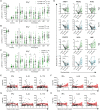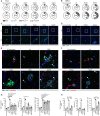Identification of four novel T cell autoantigens and personal autoreactive profiles in multiple sclerosis
- PMID: 35476434
- PMCID: PMC9045615
- DOI: 10.1126/sciadv.abn1823
Identification of four novel T cell autoantigens and personal autoreactive profiles in multiple sclerosis
Abstract
Multiple sclerosis (MS) is an inflammatory disease of the central nervous system (CNS), in which pathological T cells, likely autoimmune, play a key role. Despite its central importance, the autoantigen repertoire remains largely uncharacterized. Using a novel in vitro antigen delivery method combined with the Human Protein Atlas library, we screened for T cell autoreactivity against 63 CNS-expressed proteins. We identified four previously unreported autoantigens in MS: fatty acid-binding protein 7, prokineticin-2, reticulon-3, and synaptosomal-associated protein 91, which were verified to induce interferon-γ responses in MS in two cohorts. Autoreactive profiles were heterogeneous, and reactivity to several autoantigens was MS-selective. Autoreactive T cells were predominantly CD4+ and human leukocyte antigen-DR restricted. Mouse immunization induced antigen-specific responses and CNS leukocyte infiltration. This represents one of the largest systematic efforts to date in the search for MS autoantigens, demonstrates the heterogeneity of autoreactive profiles, and highlights promising targets for future diagnostic tools and immunomodulatory therapies in MS.
Figures







Comment in
- doi: 10.1126/sciadv.abq4849
References
-
- Hemmer B., Kerschensteiner M., Korn T., Role of the innate and adaptive immune responses in the course of multiple sclerosis. Lancet Neurol. 14, 406–419 (2015). - PubMed
-
- Olsson T., Barcellos L. F., Alfredsson L., Interactions between genetic, lifestyle and environmental risk factors for multiple sclerosis. Nat. Rev. Neurol. 13, 25–36 (2017). - PubMed
-
- Wang J., Jelcic I., Mühlenbruch L., Haunerdinger V., Toussaint N. C., Zhao Y., Cruciani C., Faigle W., Naghavian R., Foege M., Binder T. M. C., Eiermann T., Opitz L., Fuentes-Font L., Reynolds R., Kwok W. W., Nguyen J. T., Lee J. H., Lutterotti A., Münz C., Rammensee H. G., Hauri-Hohl M., Sospedra M., Stevanovic S., Martin R., HLA-DR15 molecules jointly shape an autoreactive T cell repertoire in multiple sclerosis. Cell 183, 1264–1281.e20 (2020). - PMC - PubMed
-
- Elong Ngono A., Pettre S., Salou M., Bahbouhi B., Soulillou J. P., Brouard S., Laplaud D. A., Frequency of circulating autoreactive T cells committed to myelin determinants in relapsing-remitting multiple sclerosis patients. Clin. Immunol. 144, 117–126 (2012). - PubMed
-
- Olsson T., Sun J., Hillert J., Hojeberg B., Ekre H. P., Andersson G., Olerup O., Link H., Increased numbers of T cells recognizing multiple myelin basic protein epitopes in multiple sclerosis. Eur. J. Immunol. 22, 1083–1087 (1992). - PubMed
LinkOut - more resources
Full Text Sources
Other Literature Sources
Research Materials

